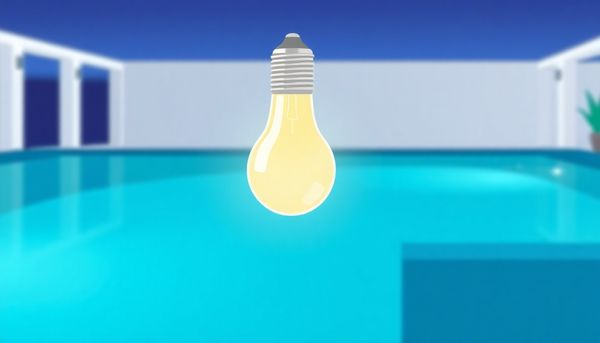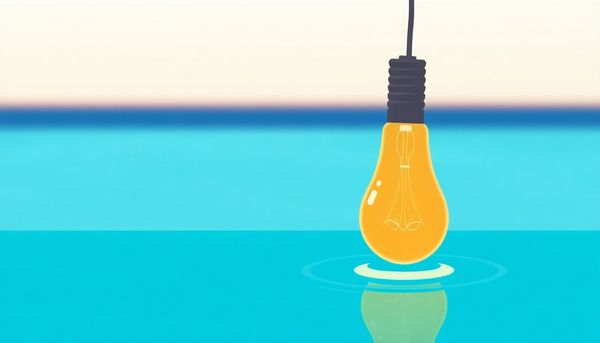How to Safely Replace Your Pool Light Bulb: A Step-by-Step Guide
July 31th, 2024
July 31th, 2024
On a warm summer evening, there's nothing quite like the soft, inviting glow coming from your pool. However, when that comforting light suddenly flickers out, it can be more than just an inconvenience; it's a disruption to the idyllic backyard retreat you've carefully crafted. Swapping out a pool light bulb might seem like a daunting task, especially when water and electricity are involved. Yet, with the right guidance and a touch of patience, the process can be as manageable as replacing any other light bulb in your home.
In my own experience, tackling the pool light replacement initially felt like an intimidating effort. Armed with a few simple tools and a determination not to end the evening in darkness, I quickly found that the task was not only doable but also surprisingly straightforward. The key lies in preparation: knowing exactly which type of bulb you need, ensuring you have the proper tools on hand, and understanding the basic steps involved in the process. All of this contributes to an efficient and safe replacement.
Understanding your pool's specific setup is crucial. Some lights are easily accessible with a simple twist of a screw, while others might require a bit more finesse. By following a clear and concise set of instructions, any pool owner can transform what seems like a complex job into a simple maintenance task, ensuring that your oasis remains lit all season long.

Ever considered how a simple upgrade can transform your nighttime swim into a magical experience? Switching to LED pool lights does just that. When the sun dips below the horizon, LED lights bring your pool to life with vibrant colors and a welcoming glow. Unlike traditional incandescent bulbs, these lights use a fraction of the energy and last significantly longer, making them a smart choice for both the environment and your wallet.
LEDs offer more than just efficiency; they’re about ambiance. Imagine hosting evening gatherings where the pool shimmer changes from a serene blue to a festive pink, captivating your guests. Even solo swims under a canopy of stars become more enchanting with the gentle hues cast by these versatile bulbs. My friend once swapped her pool lights for LEDs, and the first evening swim under the kaleidoscope of colors felt like a dive into an entirely new world.
Installation, while straightforward, does require caution. Like any electrical work near water, safety is paramount. If you’re uncertain, calling in a professional can save you time and ensure peace of mind. Once installed, you’ll find yourself eagerly looking forward to those nighttime swims, now enhanced with the dazzling effects only LED lights can provide. Embrace the change and let your pool illuminate the night.
As dusk settles, the allure of a well-lit pool becomes undeniable. It’s not just about visibility—though that’s crucial—but about crafting a mood that beckons relaxation. Installing LED lights in your pool can transform a basic swim into a mesmerizing, sensory experience. These bulbs, with their energy-efficient design, offer a spectrum of colors, allowing you to tailor your ambiance to match any occasion. Imagine choosing a soft blue light to mimic the ocean's depths for a quiet evening, or vibrant pinks and purples for a lively gathering with friends.
Years ago, I swapped out our pool's tired old halogens for LEDs, and the change was astonishing. The kids went from avoiding night swims to hosting them, eager to show off the new "light show" to their friends. Beyond aesthetics, these modern lights are kinder to the pocket, reducing energy bills substantially. A bonus, especially when they’re left on for those spontaneous midnight dips.
Enhancing your pool's nighttime vibes doesn’t require a complete overhaul, just the right bulb and a bit of imagination. With the flick of a switch, you can create a captivating oasis or a tranquil retreat. Embrace the possibilities these lights offer, and let your pool become the centerpiece of memorable evenings. So, next time you consider a late-night swim, know that your pool is ready to dazzle.
No task involving electricity and water should be taken lightly, especially when they converge in a pool setting. Ensuring a safe installation is paramount when changing a pool light bulb. Begin by isolating the power source. Find the circuit breaker linked to the pool lights and switch it off. Double-check by using a multimeter to confirm there’s no lingering voltage. Trust but verify—safety can’t be compromised.
Gather your tools and supplies before you start. Having everything within arm’s reach reduces unnecessary movement and keeps your focus on the task. Lay out your towels on the pool deck to prevent the fixture or screws from slipping into the water. This is not merely an inconvenience but a potential safety hazard if metal parts remain in the pool.
Consider the condition of your light fixture. Over time, pool lights and their components can corrode, especially in saltwater pools. Inspect the lens gasket and face ring for wear and replace them if necessary. A compromised seal can lead to water ingress, rendering the new bulb unsafe.
Lastly, after reinstallation, monitor for air bubbles when you submerge the fixture. They indicate a sealing issue that must be addressed promptly to avoid future electrical hazards. Only once you’re confident of a secure and watertight installation should you restore power.
Taking these precautions helps ensure your pool not only looks inviting at night but remains a safe and enjoyable space for everyone.
When it comes to illuminating your pool, opting for energy-efficient LED bulbs is akin to adding the final brushstroke to a masterpiece. Unlike traditional incandescent bulbs, LEDs sip power rather than guzzle it, reducing your energy bill while extending the bulb's lifespan. I recall swapping out the old bulbs in our family pool for LEDs; not only did the colors transform our evening swims into vibrant light shows, but the cost savings were undeniable.
LEDs shine brighter, making them ideal for nighttime swims under the stars. They offer a variety of hues, turning a simple evening dip into an atmospheric experience—perfect for spontaneous pool parties or serene solo swims. My favorite part? Watching the water shift from a calming blue to a playful pink, adding a splash of magic to our backyard.
Beyond aesthetics and savings, LEDs also contribute to eco-friendly living. Their durability means fewer replacements, leading to less waste. Installing these bulbs might initially feel like a splurge, but the long-term benefits far outweigh the upfront cost.
So, as you prepare to replace those pool light bulbs, consider the LED option. It’s an investment in both ambiance and efficiency, ensuring your pool remains a glowing oasis well into the night.

When preparing to replace your pool light bulb, prioritizing safety not only protects you but ensures the longevity of your pool's electrical components. Before beginning, make sure the power to the pool area is completely turned off. This might seem like an obvious step, but it’s crucial. A helpful habit I’ve developed is using a multimeter to test the wires, ensuring zero voltage. It's a small device that offers big peace of mind.
Consider the tools you'll need for the job. A reliable screwdriver set, preferably one with multiple bits, can save you time and effort. Also, having a dry, non-slip surface nearby to place components as you disassemble the light fixture is wise. While some may choose to partially drain the pool for easier access to the light, remember that water levels and chemical balances will need attention afterward.
For those feeling a bit uneasy about handling the task, don't hesitate to reach out to a professional. There’s no shame in ensuring the task is done safely and correctly. Additionally, if your fixture appears corroded or damaged, professional advice can be invaluable in deciding whether it’s time for a replacement rather than just a bulb change.
Navigating pool maintenance doesn’t have to be daunting, but it should always be approached with caution and care. After all, nothing’s better than enjoying a well-lit, safe swim under the stars, knowing all precautions were taken.
#

Replacing a burned-out pool light bulb may sound like a straightforward task, but safety must remain your foremost concern, given the electrified environment underwater. Ensuring the power is completely cut off to the pool area is the most critical step. Triple-check this before touching any components. Once you're confident there's no electricity flowing, gather your tools and materials—such as a screwdriver, multimeter, and replacement bulb—before diving into the task.
Starting by unscrewing the light fixture, you're likely to find the bulb nestled within. It might seem daunting, but remember, each screw holds the potential to release the glow back into your nighttime swims. Use the multimeter to confirm there's no electrical current before proceeding. A gentle hand is required when removing the fixture; the wires should be long enough to let it rest on the deck, ensuring no debris contaminates the pool during the process.
Disassemble the lens and gasket carefully, taking note of any corrosion. Clean the area thoroughly with a dry towel, and examine if the corrosion requires a full assembly replacement. Installing the new bulb is like threading a needle—tighten it securely, but gently, to avoid damage. Once reassembled, a quick test will confirm your success. Watch for air bubbles when submerging the fixture again; they betray an incomplete seal. Rinse and repeat this step until perfect. With a successful installation, you’ll add a new skill to your DIY collection and transform your pool into a shimmering oasis under the stars.
When transforming a regular pool area into an enchanting nighttime oasis, upgrading to energy-efficient LED bulbs makes a significant difference. Not only do these bulbs glow brighter than traditional incandescent ones, but they also operate on a fraction of the power. This means you can bask in that inviting glow for hours without fretting over energy bills. Many LED options come with customizable color settings, allowing you to switch from calming blues to vibrant pinks with just a click, turning a quiet evening swim into a festive party poolside.
Some years back, a friend swapped their pool lights for LEDs and couldn’t stop raving about the electric bill reduction. In addition to energy savings, longevity is another major advantage. LED bulbs are known for their extended lifespan, often lasting ten times longer than their incandescent counterparts. This means less frequent replacements and more time enjoying the pool under twinkling lights.
When contemplating this upgrade, consider the pool light's compatibility. Some fixtures may require specific LED models, so it's essential to check before purchasing. If you're unsure, consulting a professional might be wise, ensuring a seamless transition. Once installed, the captivating colors and reduced energy consumption will undoubtedly enhance every swim, making each plunge into the water feel like a dive into a dazzling dream.
Navigating the maze of pool light maintenance can sometimes feel like trying to solve a riddle where the stakes are high and the answers murky. Sure, changing a pool light bulb seems straightforward, but when it comes to submerged fixtures and the ever-present danger of mixing electricity with water, the task becomes more nuanced.
A seasoned professional arrives with a toolkit of specialized knowledge and equipment, demystifying the complexities that might leave a DIY enthusiast scratching their head. They bring an understanding of the nuances of electrical systems tailored specifically for pools, ensuring that every connection is safe and secure. My neighbor recently had a pro come in after a frustrating weekend trying to fix it himself; the technician had everything sorted in a fraction of the time, with zero stress.
Additionally, pros can often spot issues that might not be on the radar of a casual pool owner. They might identify potential water seepage problems or recommend LED upgrades that save energy and enhance the poolside experience. This comprehensive service means far less hassle for you and more time enjoying those moonlit swims.
Entrusting the task to a professional isn’t just about the peace of mind that comes with knowing your pool is safe—it's also about enhancing your enjoyment and convenience. So, the next time your pool light flickers and fails, consider calling in a pro to bring the sparkle back to your underwater oasis.

Replacing a burned-out pool light bulb isn’t just a task; it's an opportunity to reclaim those enchanting nighttime swims. One summer, I found myself diving into my own pool, greeted only by a dim, eerie glow reminiscent of a spooky film set. It was clear that action was needed. Fortunately, swapping out a bulb is straightforward—though a touch more involved than changing a lamp bulb in your living room.
First things first, ensure safety. Power down the pool lights completely. Trust me, you’ll want to triple-check this. A friend once ignored this step and ended up with a hair-raising story rather than a glowing pool. After confirming the power is off, gather your tools: a screwdriver, a replacement bulb (preferably LED for efficiency), and a multimeter to double-check for any stray currents.
Next, tackle the fixture. Loosen the screws with your trusty screwdriver, carefully lifting the light from its watery enclosure. Most pool lights have enough wiring to let you rest them on the pool deck, away from the water’s edge. It’s crucial here to handle the bulb gently. Remove the old bulb with a towel-covered hand to avoid any mishaps with slippery fingers.
Once the new bulb is securely in place, test it quickly—just a flick to ensure it lights up—and then submerge the fixture back into its watery home. No bubbles should escape; if they do, reassemble and test again. With the pool glowing once more, you’ve not only restored the magic of nighttime swims but also honed a valuable DIY skill. Now, about that celebratory swim—don’t forget to invite a friend!
Ensuring safety is not just a step—it's the entire staircase when it comes to changing a pool light bulb. Every part of the process demands caution, especially considering the precarious dance between water and electricity. Before you even think about reaching for a screwdriver, the first order of business is flipping the switch and cutting off all electrical power to the pool area. You might feel like you’re being overly cautious, but when it comes to electrical safety, it pays to be thorough. Triple-checking that all circuits are indeed off is not a step to be rushed.
Next, consider your tools. Using a quality screwdriver with a comfortable grip is not just about convenience; it reduces the risk of slipping—important when your hands might be a bit damp. When dealing with screws and small metal parts, work away from the pool edge. You wouldn’t want to fish those out of the water.
Personal anecdotes remind us that safety gear is your best friend. Gloves provide a non-slip grip and some insulation, while goggles protect your eyes from any unexpected splashes or debris. For those of us who tend to get a bit clumsy around the pool, setting up a dry towel nearby offers a safe landing spot for tools and components.
Lastly, if the thought of handling these electrical connections makes your heart race, don't hesitate to call in a professional. Your peace of mind, and safety, are worth every penny.
Switching to LED lighting can transform your pool into a vibrant, energy-efficient oasis, perfect for those enchanting nighttime swims. When I swapped out my own pool lights for LED bulbs, the difference was like moving from an old black-and-white movie to a brilliant technicolor film. The immediate appeal of LEDs is their energy efficiency. These bulbs consume much less power than traditional incandescent bulbs, which not only reduces your electricity bill but also contributes to a greener planet.
Moreover, LED bulbs outshine their predecessors with a dazzling array of colors, providing a customizable glow that can match any mood or occasion. Imagine hosting an evening pool party where the water shimmers in hues of blue, green, or purple, creating an atmosphere straight out of a tropical resort. This was exactly what happened at my last get-together, and my guests were thoroughly impressed with the vibrant display. Plus, with longer lifespans, you’ll spend less time on the ladder and more time enjoying the water.
If you're considering this upgrade, remember that safety comes first. Make sure all power is off before starting the installation. For those unsure about tinkering with pool wiring, hiring a professional can ensure both a seamless transition and peace of mind. Dive into the future of pool lighting and let your backyard become the neighborhood’s nighttime hot spot.
Testing and reassembling fixtures isn't just the final puzzle piece—it’s the moment of truth. You’ll be standing there, tools in hand, the pool light ready to return to its watery home. Before it takes the plunge, make sure everything is working perfectly. Flicking the switch to see the glow is more than just a light test; it's a brilliant affirmation of your efforts. But here’s a trick: only turn it on for a brief moment, since out-of-water operation isn’t a pool light’s best friend.
Once you've confirmed that your new bulb shines like a star, it's time to power down again. Safety comes first, even when you're on the brink of victory. With the fixture dry and all components snugly fitted, give it another glance. Look for errant air bubbles when submerged, an indication of a less-than-perfect seal. Seeing bubbles? No worries. Just repeat the drying and sealing steps until your fixture rests underwater without a trace of air escaping.
Rewinding the wiring back into its snug compartment demands patience. Carefully nestle the light fixture into its rightful place against the pool wall, ensuring screws align perfectly. This alignment isn’t just about aesthetics; it's about ensuring a secure fit. Once everything is tightly fastened, flip the switch again. Watching the pool light beam across the water, you can finally breathe a sigh of relief. Now, your pool is ready for evening splendor, inviting both starry reflections and joyous splashes.

Testing the functionality of your newly installed pool light is a moment of anticipation and satisfaction. With the bulb snugly in place, reassemble the fixture carefully, ensuring all seals are tight to prevent any water ingress. Once you’ve completed the assembly, it's time to restore power cautiously. A flick of the switch should illuminate your pool with vibrant light, casting a welcoming glow across the water’s surface.
After verifying the light comes on, it’s crucial to turn it off immediately. Pool lights are designed to cool off in water, and leaving them on while dry can lead to overheating and potential damage. Before you submerge the fixture back into its watery home, observe closely for any air bubbles escaping from the edges. If bubbles appear, it suggests a compromised seal, and the fixture will need to be re-dried and tightened further to ensure watertight safety.
Once satisfied with the seal, gently tuck the excess wire back into the wall, sliding the fixture into its designated spot. Align the screw holes carefully and secure the fixture in place. With a final test, switch the power back on to confirm consistent lighting. Seeing your pool aglow with the new bulb signifies not just a job well done but also the promise of many enjoyable evenings spent swimming under the stars, free from lurking shadows.
If you've ever stood poolside, wrench in hand, ready to tackle a seemingly simple bulb change, you know the curious mix of excitement and caution it brings. Before diving into any task involving electricity and water, a careful approach is essential. Think of pool safety as your trusty lifeguard, always there to keep things in check.
First, ensure that the power to the pool area is completely shut off. This step cannot be overstated; triple-checking is not just advisable—it's mandatory. Electricity coursing through water is a recipe for disaster, and vigilance is your best friend here. Armed with a multimeter, verify that the wires are indeed lifeless before you proceed. It's a small device that could make the difference between a smooth repair and an unfortunate incident.
When you're ready to begin, gather the right tools—screwdrivers, towels, and the new bulb—and have them on standby. If you feel uneasy about handling such tasks, don't hesitate to call in a professional. Hiring someone experienced can save you from potential hazards and give you peace of mind.
With the groundwork laid for a secure repair, you can focus on the task at hand. By prioritizing safety, you aren't just protecting yourself; you're ensuring every swim under that newly lit pool is as enjoyable as it is safe.
When it comes to updating your pool's ambiance, upgrading to energy-efficient lighting is an excellent step. Pool lights have evolved significantly, and swapping out the old for new LED bulbs can transform your swim experience. Not only do these modern marvels sip electricity, they also offer vibrant color options that can turn a mundane night swim into a dazzling aquatic event. Imagine your pool glowing in hues of blue, green, or even a playful pink—adding a dash of excitement to any evening gathering.
Think about the long-term benefits, too. LED bulbs often outlast traditional incandescent options by miles. This means fewer changes and more time enjoying the water. Plus, LEDs are kinder to the planet, aligning with a more sustainable lifestyle. Energy-efficient lighting is a win-win: reducing your carbon footprint while keeping your electricity bills in check.
Personal anecdotes often highlight the change best. I once helped a friend replace their pool lights with LEDs. By the next evening party, the pool had become the centerpiece, with guests marveling at the light show. The transformation was not just visual but atmospheric, as the gentle glow set a mood that was both enchanting and modern.
Upgrading your pool lighting is not just about seeing in the dark—it's about enhancing the experience and creating memories, while also being mindful of energy consumption. Embrace the change and dive into a brighter, more efficient future.
The allure of a nighttime swim is undeniably enhanced by a well-lit pool, transforming your backyard into a shimmering oasis. To achieve this magical setting, replacing a faulty pool light bulb is crucial. So, with sleeves rolled up and tools at hand, let’s embark on this small adventure.
First, gather your supplies: a new pool light bulb, a set of screwdrivers (both flathead and Phillips), a towel, and a multimeter. These are your trusty allies in ensuring a successful operation. Safety reigns supreme here, so double and triple-check that all power to the pool area is completely off; checking with a multimeter is essential.
Once you're sure it’s safe, proceed to unscrew the fixture from the pool wall. Usually, there’s plenty of wire to bring the fixture up to deck level. Place it on a towel to prevent scratches. Carefully disassemble the fixture by removing screws or clamps to expose the bulb. Handle each part with care, especially if corrosion has taken its toll.
After removing the old bulb, clean the fixture’s interior with a towel to eliminate any lingering debris. Install the new bulb, ensuring it's secure but not over-tightened to avoid breakage. Reassemble the fixture, ensuring a watertight seal with the lens gasket.
Before reinstalling, briefly test the bulb to confirm it lights up, remembering to switch the power back off immediately afterward. Reattach the fixture, ensuring no air bubbles escape upon submersion. Once it's securely in place, restore power and revel in the glow.
Congratulations, you've not only revived your pool's allure but also added a new skill to your DIY repertoire. Now, let the evening swims commence, complete with enchanting lighting and perhaps a splash of color from an LED bulb.

Careful handling of pool light fixtures isn't just a suggestion—it's a necessity. After all, these fixtures are designed to resist water intrusion while enduring the wear and tear of a chlorinated environment. When you're about to replace a light bulb, it's crucial to treat these components with respect. Pool lights, much like delicate watch mechanisms, demand a gentle touch.
Consider how vital it is to ensure the fixture remains dry inside. Moisture can easily sneak in if the lens is not properly sealed, leading to bigger issues like corrosion or electrical shorts. Personally, I've seen a friend's pool party cut short because of a hasty bulb change that left the fixture compromised, resulting in a flickering light show no one wanted. A small misstep can turn into a major inconvenience.
Always dismantle the fixture over a dry surface, preventing any accidental parts drop into the pool. Pay attention to the lens gasket; it might look like an insignificant rubber ring, but it plays a pivotal role in maintaining a watertight seal. If it appears cracked or worn, replacing it is a wise move. This might seem like a trivial detail, but missing it can lead to water seeping into a fixture, slowly eroding its integrity.
In the end, by handling these fixtures with patience and precision, you ensure not just a well-lit pool but also a safe swimming environment. Investing extra care now saves you from future headaches, and lets you enjoy those starry night swims without a hitch.
Navigating the task of changing a pool light bulb begins with an unwavering commitment to safety. Before you even think about tackling that flickering light, take a moment to prepare your workspace and mindset. Start with the basics: head to the breaker box and cut power to the pool area. This step can't be stressed enough. Just imagine the consequences of overlooking this simple precaution—electricity and water are a perilous combination.
Next, arm yourself with the right tools. A reliable multimeter becomes your best friend here, ensuring no current is sneaking through the wires. Personal anecdotes remind us that even seasoned DIY enthusiasts have faced surprises when a forgotten switch was left on. Double-check, then triple-check, that the power is indeed off.
Consider the environment. If your pool is still filled, be mindful of wet surfaces that could lead to slips or falls. A pair of non-slip shoes goes a long way in preventing accidents. Moreover, keep a sturdy towel or two nearby—useful for handling wet fixtures and keeping your tools dry.
Lastly, assess your own comfort level. Not everyone is cut out for tasks that combine electricity and water. If there's any doubt, calling a professional is not a sign of defeat but a wise decision. After all, the peace of mind knowing the job is done safely is well worth it. With these precautions in place, you're set to proceed confidently, knowing you've prioritized safety above all.
In the world of DIY pool maintenance, the key to success starts with assembling the right arsenal of tools. The difference between a smooth bulb change and a frustrating mishap often hinges on having the proper equipment ready before diving into the task. When I first tackled my pool light replacement, I underestimated the importance of tool selection, leading to an extra trip to the store—avoid that pitfall by preparing in advance.
A dependable screwdriver is your first essential. Depending on the fixture, you might need either a flathead or Phillips screwdriver. I recommend a versatile, multi-bit ratcheting screwdriver for its adaptability and comfort, especially when dealing with the varied screws found in pool lighting fixtures. This handy tool saved me time and effort during my own light replacement adventure.
Safety is paramount, which brings us to the multimeter. This device lets you confirm there's no electricity flowing through the wires, a crucial step when you're working in a wet environment. The peace of mind it provides is invaluable—always double-check the power is completely off before proceeding.
Don’t forget a couple of clean, dry towels. They’re not just for drying your hands; they provide a soft surface to set down the light fixture, preventing scratches and keeping everything tidy. Lastly, have a pair of gloves handy. They offer better grip and protect your hands from any potential corrosion on the old fixture.
Choosing and organizing these tools beforehand turns a potentially daunting task into a manageable one. With preparation, changing a pool light bulb becomes another notch on your DIY belt.

This article provided insights into maintaining your pool. Start your pool care journey today!
Want to become a pool maintenance expert? Our free Pool School course covers everything you need to know about pool care. From basic maintenance to advanced troubleshooting, you'll learn how to:
Join over 10,000 pool owners who have already transformed their pool care routine. Get started with our free Pool School course today!